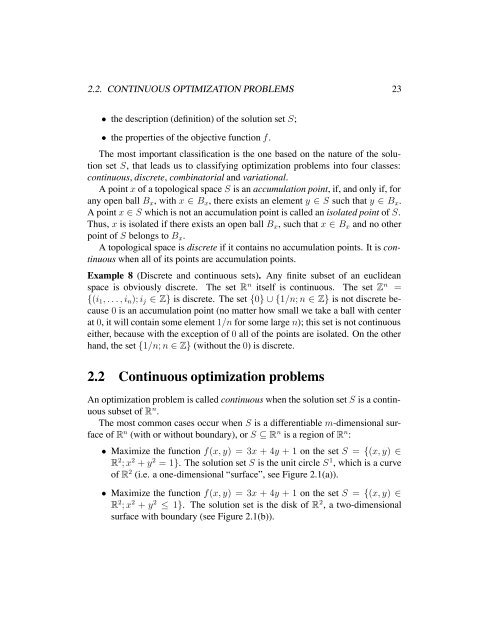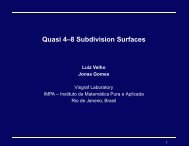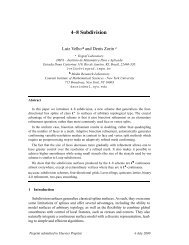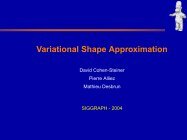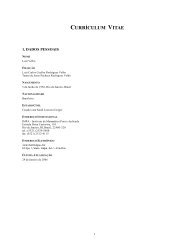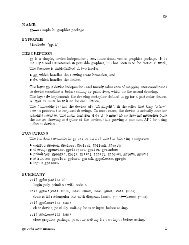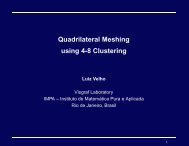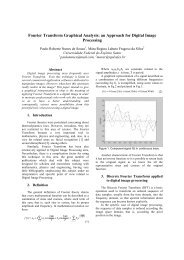Mathematical Optimization in Graphics and Vision - Luiz Velho - Impa
Mathematical Optimization in Graphics and Vision - Luiz Velho - Impa
Mathematical Optimization in Graphics and Vision - Luiz Velho - Impa
You also want an ePaper? Increase the reach of your titles
YUMPU automatically turns print PDFs into web optimized ePapers that Google loves.
2.2. CONTINUOUS OPTIMIZATION PROBLEMS 23<br />
• the description (def<strong>in</strong>ition) of the solution set S;<br />
• the properties of the objective function f.<br />
The most important classification is the one based on the nature of the solution<br />
set S, that leads us to classify<strong>in</strong>g optimization problems <strong>in</strong>to four classes:<br />
cont<strong>in</strong>uous, discrete, comb<strong>in</strong>atorial <strong>and</strong> variational.<br />
A po<strong>in</strong>t x of a topological space S is an accumulation po<strong>in</strong>t, if, <strong>and</strong> only if, for<br />
any open ball B x , with x ∈ B x , there exists an element y ∈ S such that y ∈ B x .<br />
A po<strong>in</strong>t x ∈ S which is not an accumulation po<strong>in</strong>t is called an isolated po<strong>in</strong>t of S.<br />
Thus, x is isolated if there exists an open ball B x , such that x ∈ B x <strong>and</strong> no other<br />
po<strong>in</strong>t of S belongs to B x .<br />
A topological space is discrete if it conta<strong>in</strong>s no accumulation po<strong>in</strong>ts. It is cont<strong>in</strong>uous<br />
when all of its po<strong>in</strong>ts are accumulation po<strong>in</strong>ts.<br />
Example 8 (Discrete <strong>and</strong> cont<strong>in</strong>uous sets). Any f<strong>in</strong>ite subset of an euclidean<br />
space is obviously discrete. The set R n itself is cont<strong>in</strong>uous. The set Z n =<br />
{(i 1 , . . . , i n ); i j ∈ Z} is discrete. The set {0} ∪ {1/n; n ∈ Z} is not discrete because<br />
0 is an accumulation po<strong>in</strong>t (no matter how small we take a ball with center<br />
at 0, it will conta<strong>in</strong> some element 1/n for some large n); this set is not cont<strong>in</strong>uous<br />
either, because with the exception of 0 all of the po<strong>in</strong>ts are isolated. On the other<br />
h<strong>and</strong>, the set {1/n; n ∈ Z} (without the 0) is discrete.<br />
2.2 Cont<strong>in</strong>uous optimization problems<br />
An optimization problem is called cont<strong>in</strong>uous when the solution set S is a cont<strong>in</strong>uous<br />
subset of R n .<br />
The most common cases occur when S is a differentiable m-dimensional surface<br />
of R n (with or without boundary), or S ⊆ R n is a region of R n :<br />
• Maximize the function f(x, y) = 3x + 4y + 1 on the set S = {(x, y) ∈<br />
R 2 ; x 2 + y 2 = 1}. The solution set S is the unit circle S 1 , which is a curve<br />
of R 2 (i.e. a one-dimensional “surface”, see Figure 2.1(a)).<br />
• Maximize the function f(x, y) = 3x + 4y + 1 on the set S = {(x, y) ∈<br />
R 2 ; x 2 + y 2 ≤ 1}. The solution set is the disk of R 2 , a two-dimensional<br />
surface with boundary (see Figure 2.1(b)).


